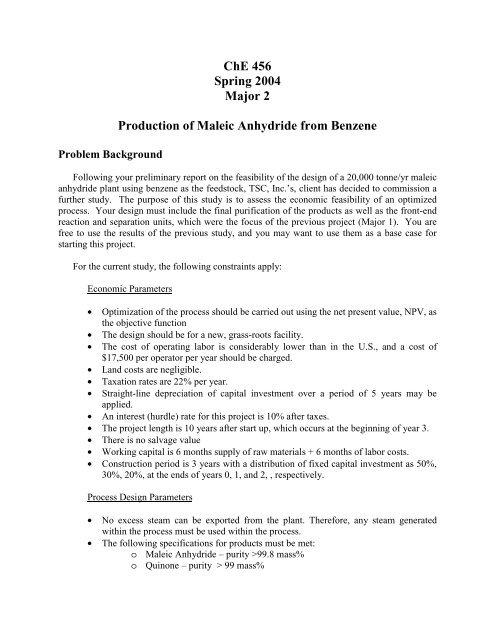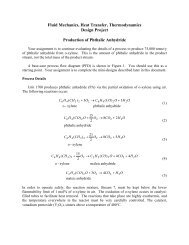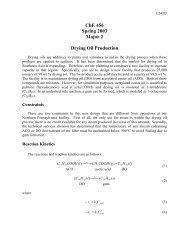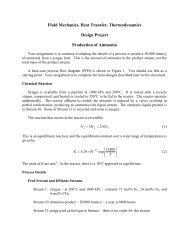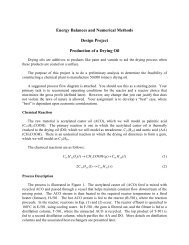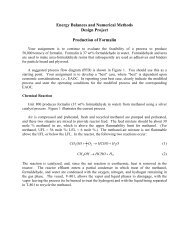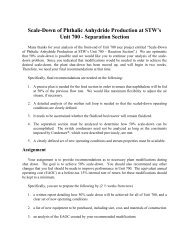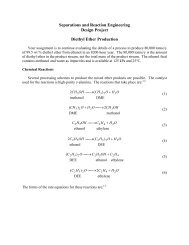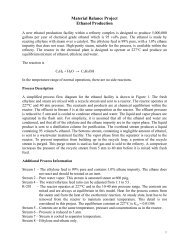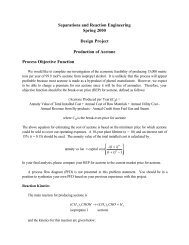ChE 456 Spring 2004 Major 2 Production Of Maleic Anhydride
ChE 456 Spring 2004 Major 2 Production Of Maleic Anhydride
ChE 456 Spring 2004 Major 2 Production Of Maleic Anhydride
You also want an ePaper? Increase the reach of your titles
YUMPU automatically turns print PDFs into web optimized ePapers that Google loves.
Problem Background<br />
<strong>ChE</strong> <strong>456</strong><br />
<strong>Spring</strong> <strong>2004</strong><br />
<strong>Major</strong> 2<br />
<strong>Production</strong> of <strong>Maleic</strong> <strong>Anhydride</strong> from Benzene<br />
Following your preliminary report on the feasibility of the design of a 20,000 tonne/yr maleic<br />
anhydride plant using benzene as the feedstock, TSC, Inc.’s, client has decided to commission a<br />
further study. The purpose of this study is to assess the economic feasibility of an optimized<br />
process. Your design must include the final purification of the products as well as the front-end<br />
reaction and separation units, which were the focus of the previous project (<strong>Major</strong> 1). You are<br />
free to use the results of the previous study, and you may want to use them as a base case for<br />
starting this project.<br />
For the current study, the following constraints apply:<br />
Economic Parameters<br />
• Optimization of the process should be carried out using the net present value, NPV, as<br />
the objective function<br />
• The design should be for a new, grass-roots facility.<br />
• The cost of operating labor is considerably lower than in the U.S., and a cost of<br />
$17,500 per operator per year should be charged.<br />
• Land costs are negligible.<br />
• Taxation rates are 22% per year.<br />
• Straight-line depreciation of capital investment over a period of 5 years may be<br />
applied.<br />
• An interest (hurdle) rate for this project is 10% after taxes.<br />
• The project length is 10 years after start up, which occurs at the beginning of year 3.<br />
• There is no salvage value<br />
• Working capital is 6 months supply of raw materials + 6 months of labor costs.<br />
• Construction period is 3 years with a distribution of fixed capital investment as 50%,<br />
30%, 20%, at the ends of years 0, 1, and 2, , respectively.<br />
Process Design Parameters<br />
• No excess steam can be exported from the plant. Therefore, any steam generated<br />
within the process must be used within the process.<br />
• The following specifications for products must be met:<br />
o <strong>Maleic</strong> <strong>Anhydride</strong> – purity >99.8 mass%<br />
o Quinone – purity > 99 mass%
o <strong>Maleic</strong> Acid – purity > 99.8 mass%<br />
• Any liquid organic stream may be burned in a fired heater as fuel, and a credit may be<br />
taken for the fuel value (LHV) of the stream.<br />
• All distillation columns must be simulated using rigorous unit operations (either<br />
TOWR or SCDS in Chemcad). Failure to use rigorous algorithms in the final case<br />
will result is a loss of credit. Preliminary screening using short-cut methods is<br />
acceptable.<br />
• The ideal vapor pressure K-value and latent heat Enthalpy options should be used for<br />
the Chemcad simulation.<br />
In performing your study, you may wish to consider the following suggestions regarding the<br />
optimization.<br />
Process Design Hints<br />
• For the maleic anhydride process to have any chance of being profitable, the<br />
integration of process energy must be carefully planned. It is suggested that your<br />
study include a detailed heat exchange network design.<br />
• In order to limit excessive reboiler and condenser duties on towers, the recycle<br />
flowrate of dibutylphthalate solvent should be limited. In addition, the severe<br />
recovery and purification specifications of this solvent should be carefully evaluated.<br />
For example, in <strong>Major</strong> 1, the purity of the solvent leaving the bottom of tower, T-502<br />
was > 0.9999. If this purity specification is relaxed, to say 0.99, then the duty of the<br />
reboiler for T-502 is greatly reduced.<br />
• For the by-products (quinone and maleic acid), the option of not purifying them but<br />
using them for fuel credit should be considered. An incremental comparison between<br />
the cost of separation and the loss in revenue from pure by-products should be used to<br />
determine the optimal strategy.<br />
Report Format<br />
This report should be comprehensive and should conform to the guidelines. It should be<br />
bound in a folder that is not oversized relative to the number of pages in the report. Figures and<br />
tables should be included as appropriate. An appendix should be attached that includes items<br />
such as Chemcad output and sample calculations. These calculations should be easy to follow.<br />
The confidentiality statement should be the very last page of the report.<br />
The written report is a very important part of the assignment. Reports that do not conform to<br />
the guidelines will receive severe deductions and will have to be rewritten to receive credit.<br />
Poorly written and/or organized written reports may also require re-writing. Be sure to follow<br />
the format outlined in the guidelines for written reports.<br />
The following information, at a minimum, must appear in the main body of the final report:<br />
1. a computer-generated PFD (not a Chemcad PFD) for the recommended optimum case,<br />
2
2. a stream table containing the usual items,<br />
3. a list of new equipment for the process, including bare module and installed costs, plus<br />
equipment specifications (presented with a reasonable number of significant figures),<br />
4. a summary table of all utilities used,<br />
5. a clear summary of alternatives considered and a discussion, supported with figures, of<br />
why the chosen alternative is superior,<br />
6. a clear economic analysis which justifies the recommended case<br />
7. a Chemcad report only for your optimized case (in the Appendix). This must contain the<br />
equipment connectivity thermodynamics, and overall material balance cover pages,<br />
stream flows, equipment summaries, tower profiles, and tray design specifications (if you<br />
use Chemcad to design the trays). It should not contain stream properties. Missing<br />
Chemcad output will not be requested; credit will be deducted as if the information is<br />
missing.<br />
Oral Presentation<br />
You will be expected to present and defend your results some time between February 23,<br />
<strong>2004</strong> and February 26, <strong>2004</strong>. Your presentation should be 15-20 minutes, followed by about a<br />
30 minute question and answer period. Make certain that you prepare for this presentation since<br />
it is an important part of your assignment. You should bring at least one hard copy of your slides<br />
to the presentation and hand it out before beginning the presentation.<br />
Other Rules<br />
You may not discuss this major with anyone other than the instructors. Discussion,<br />
collaboration, or any other interaction with anyone other than the instructors is prohibited.<br />
Violators will be subject to the penalties and procedures outlined in the University Procedures<br />
for Handling Academic Dishonesty Cases (begins on p. 47 of both the 2001-03 and 2003-05<br />
Undergraduate Catalogs).<br />
Consulting is available from the instructors. Chemcad consulting, i.e., questions on how to<br />
use Chemcad, not how to interpret results, is unlimited and free, but only from the instructors.<br />
Each individual may receive five free minutes of consulting from the instructors. After five<br />
minutes of consulting, the rate is 2.5 points deducted for 15 minutes or any fraction of 15<br />
minutes, on a cumulative basis. The initial 15-minute period includes the 5 minutes of free<br />
consulting.<br />
Late Reports<br />
Late reports are unacceptable. The following severe penalties will apply:<br />
3
• late report on due date before noon: one letter grade (10 points)<br />
• late report after noon on due date: two letter grades (20 points)<br />
• late report one day late: three letter grades (30 points)<br />
• each additional day late: 10 additional points per day<br />
4
Appendix 1<br />
Reaction Kinetics<br />
The reactions and reaction kinetics are the same as given in the first assignment and are<br />
repeated below:<br />
k1<br />
6 6 + 2 ⎯⎯→ 4 2 3 + 2 + 2<br />
CH( g) 4.5 O( g) CHO( g) 2 CO( g) 2 HOg ( )<br />
benzene<br />
maleic anhydride<br />
k2<br />
6 6 + 2 ⎯⎯→ 2 + 2<br />
CH( g) 7.5 O( g) 6 CO( g) 3 HOg ( )<br />
benzene<br />
k3<br />
4 2 3 + 2 ⎯⎯→ 2 + 2<br />
CHO( g) 3 O( g) 4 CO( g) HOg ( )<br />
maleic anhydride<br />
(A.1)<br />
(A.2)<br />
(A.3)<br />
k4<br />
6 6 + 2 ⎯⎯→ 6 4 2 + 2<br />
CH( g) 1.5 O( g) CHO( g) HOg ( )<br />
benzene<br />
quinone<br />
(A.4)<br />
where<br />
and<br />
− r = kC or − r3 = k3C maleic anhydride<br />
(A.5)<br />
i i benzene<br />
6<br />
k1 = 7.7 × 10 exp( − 25,143/ RT)<br />
(A.6)<br />
7<br />
k2 = 6.31× 10 exp( − 29,850 / RT)<br />
(A.7)<br />
4<br />
k3 = 2.33× 10 exp( − 21,429 / RT)<br />
(A.8)<br />
5<br />
k4 = 7.20 × 10 exp( − 27,149 / RT)<br />
(A.9)<br />
The units of reaction rate, r i , are kmol/m 3 (reactor)s, the activation energy is given in cal/mol<br />
(which is equivalent to kcal/kmol), the units of k i are m 3 (gas)/m 3 (reactor)s, and the units of<br />
concentration are kmol/m 3 (gas).<br />
The catalyst is a mixture of vanadium and molybdenum oxides on an inert support. Typical<br />
inlet reaction temperatures are in the range of 350-400°C. The catalyst is placed in 25 mm<br />
diameter tubes that are 3.2 m long. The catalyst pellet diameter is 5 mm. The maximum<br />
temperature that the catalyst can be exposed to without causing irreversible damage (sintering) is<br />
650°C.<br />
For the fluidized bed reactor, you should use the same catalyst size and assume a particle<br />
density of 1200 kg/m 3 . In a packed bed, the void fraction of the bed is 0.5.<br />
5
Appendix 2<br />
Chemcad Hints<br />
In order to simulate the temperature spike in the reactor, the reactor is simulated as a cocurrent,<br />
packed bed kinetic reactor, with a molten salt stream as the utility. The kinetics given in<br />
Appendix A are used in the simulation.<br />
For the simulation of the reactor as a fluidized bed, the reactor should be modeled as an<br />
isothermal plug flow reactor with 10% of the feed bypassing the reactor. This simulation is<br />
necessary to capture the isothermal nature of the fluidized bed but also to take into account the<br />
fact that the reactor feed bypasses the catalyst in the form of bubbles.<br />
As with the previous project, any water absorbed in T-501 will react with maleic anhydride<br />
to produce maleic acid. The simulation of this reaction should be done in the same way as in<br />
<strong>Major</strong> 1.<br />
6
Appendix 3<br />
Raw Material Costs<br />
Chemical<br />
Price/Cost, $/kg<br />
Dibutylphthalate 1.72<br />
Benzene 0.45<br />
<strong>Maleic</strong> <strong>Anhydride</strong> 0.93<br />
<strong>Maleic</strong> Acid 0.90<br />
Quinone 0.70<br />
For utility costs, use the values in Chapter 6 of Analysis, Synthesis, and Design of Chemical<br />
Processes, R. Turton, R.C. Bailie, W.B. Whiting, and J.A. Shaeiwitz, 2 nd ed., Prentice-Hall,<br />
2003.<br />
7


